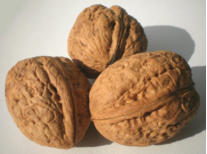





English walnut
Walnut and its close relatives are broadly distributed across North and South America, Europe, and Asia. Spanish missionaries first
introduced English walnut (Juglans regia) to California in the 1700s and commercial walnut production began in the mid to late 1800s
(Leslie and McGranahan 1998). Almost all walnuts grown for their nuts in the United States are produced in California, although a small
proportion of walnuts are also grown in the Midwest. In 2012, 627,921 tons of walnuts were produced on 312,323 acres in California with
an estimated value of $1,802,586,000 (CA Ag. Comissioners' Rpt 2012).
Walnuts belong to the genus Juglans within the family Juglandaceae. Other well-known
relatives in the Juglandaceae family include pecan, wingnut, and hickory. Most species
within the Juglans genus can be hybridized, and are valued for their wood and/or nuts.
The English walnut, (Juglans regia) also known as Persian walnut, is the most commonly
grown walnut for nut production. The Northern California black walnut (Juglans hindsii)
and the hybrid ‘Paradox’ (J. hindsii x J. regia) are used primarily as a rootstock for the
English scion.
Rootstock selection.
Rootstocks are bred to grow in different soil types and conditions, and provide the best anchorage, vigor, and resistance or tolerance to
soil borne pests and diseases. However, no individual rootstock is tolerant of all factors that impact walnut production. The strengths
and weaknesses of each rootstock should be considered in the context of a specific orchard location. Traditionally two rootstock choices
have been available to the walnut industry in California, seedling Northern California black walnut (J. hindsii) and seedling Paradox.
Paradox rootstock is a hybrid, produced from a Northern California black walnut tree pollinated by an English walnut. In recent years,
three clonal Paradox rootstocks have become available; Vlach, RX1 and VX211. A few growers also use own-rooted English walnuts in
areas where blackline disease is prevalent.
Northern California black walnut seedlings provide a less vigorous rootstock that is less susceptible to crown gall (Agrobacterium
tumefaciens) than Paradox, but more susceptible to Phytophthora crown and root rot. Paradox seedlings are more vigorous and less
susceptible to Phytophthora root rot but very susceptible to crown gall. Both of these seedling rootstocks grow poorly in the presence of
pathogenic nematodes. Each clonal Paradox rootstock has specific beneficial characteristics. For example, Vlach is vigorous and may be
moderately tolerant of crown gall compared to Paradox seedlings. VX211 is very vigorous and shows some tolerance to nematodes. RX1
is a less vigorous rootstock but has shown moderate resistance to Phytophthora citricola and high resistance to P. cinnimomi.
None of the Paradox or California black rootstocks are resistant to blackline disease. If blackline is prevalent in an area it can be avoided
entirely by growing scion varieties on their own roots but tree size, resistance to root problems, and yield may be reduced.
Scion selection.
There are more than 30 cultivars of walnut grown in California. The most popular cultivars, accounting for 80% of production, include
Chandler, Howard, Hartley and Tulare (CDFA, 2012). Several factors are important to consider when selecting a walnut cultivar including
local climate and pest conditions. Walnut requires a period of winter chill to break dormancy and initiate leaf and flower production (see
Fruit Development & Thinning for description of “chill hours” and “chill requirement”), but there is very little experimental data available
to verify specific requirements for individual cultivars. In the absence of better data, leaf-out dates provide a relative estimate of chill
requirement because early leaf dates generally correspond to a lower chill requirement.
The prevalence of blackline disease in an area will also affect the choice of scion and rootstock to plant in an orchard. Blackline disease
causes the death of the graft union after infection by a pollen-transmitted virus when trees are grafted on either black or Paradox
rootstock. It is most common in cooler areas along the coast and near the Sacramento Delta but can occur elsewhere in California. When
replanting an orchard in a blackline infected area, consider planting on English walnut or other virus-tolerant rootstock or select a new
scion cultivar with female bloom time differing from the pollen shed of any nearby infected trees. In addition to considering how a
potential scion cultivar would fare in local climate and pest conditions, growers should consider other characteristics of each cultivar
including leaf and bloom date, timing of harvest, nut quality and bearing habit
Because pollination is required to set a crop, growers should select a cultivar with overlapping male and female flower maturity or, if a
suitable pollen source is not nearby, plant a few trees of a pollinizer variety. Early leafing and flowering varieties are more exposed to
spring rains that contribute to bacterial blight and are therefore more suitable to the southern part of the Central Valley where there is
less spring rainfall. Growers should choose cultivars with harvest dates that suit their individual location including climate, expected
availability of harvest equipment and drier capacity. Harvesting earlier can help growers avoid early fall rains, and planting several
cultivars with a range of harvest dates may aid in optimizing equipment use.
Budding, Grafting and Planting Walnut Trees - UCANR
https://www.youtube.com/watch?v=KQv65gYTtNU&feature=youtu.be
http://fruitsandnuts.ucdavis.edu/
Source: http://fruitandnuteducation.ucdavis.edu/

Orechy walnuts 2009 - J.Dncsn




